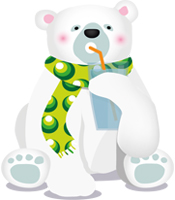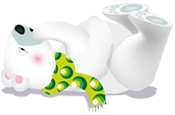It can be difficult to decide when to see a Doctor. Here we have given information about normal symptoms which usually can be safely managed at home. If you are still not sure after looking at the information, then ring your GP or 111 for advice.
Normal symptoms will often get worse and then better over the day, so watching your child’s illness over time is useful. More severe illnesses will usually get worse and worse.
Cough
 Normal coughs can last for 3-4 weeks and make your child feel quite unwell but will still get better by themselves.
Normal coughs can last for 3-4 weeks and make your child feel quite unwell but will still get better by themselves.
‘Noisy chests’ or ‘chesty coughs’ are quite common when young children catch a cold and not necessarily a sign of a ‘chest infection’.
Coughing helps the body fight against illness. The throat and upper airways produce phlegm or mucous and when the child breathes, this can sounds like a noisy ‘chest’, but this is not the same as having an infection in the chest (or lung). The mucous triggers a cough and the combination of producing mucous and coughing is part of the body’s defence system which helps keep the lungs clear and fight the illness.
Your child might have a chest infection if they have these 3 symptoms together:
- Persistent or repetitive moderately high fever
- Constant or repeated fever of over 38.5°C for 5 days
- Rapid breathing
- Babies under 6 months = over 60 breaths per minute
- Babies 6-12 months = over 50 breaths per minute
- Children over 1 year = over 40 breaths per minute
- Skin around the neck or under or between ribs being sucked in when they breathe
Healthy children typically get a cough 7-10 times a year and this is not a sign that there is anything wrong with their immune system.
Some children, even brothers and sisters, may be ill more often than others, but this is normal – some children just have cough more often and more severely.
Fever
 In children, a temperature of over 37.5°C is considered a fever.
In children, a temperature of over 37.5°C is considered a fever.
Fever is a normal response to illness and does not harm children. It may even help to fight illness by stimulating the immune system.
Children with a high temperature are a bit more likely to have a more severe illness, although most do not. A high temperature is defined as:
- for babies under 3 months = 38°C or over
- for babies 3-6 months = 39°C or over
- for children over 6 months = 40°C or over
Usually even a high temperatures will go away on its own.
Young children can sometimes have a fit (or seizure) as a result of having a temperature. It can be very scary if your child has a seizure, but children are rarely harmed by these types of fits. Child Paracetamol and Ibuprofen probably do not prevent fits.
Child not eating or drinking normally
 Children often eat and drink less when they have normal childhood illnesses. Most children can go a few days without eating much and this will not affect their longer term growth and development.
Children often eat and drink less when they have normal childhood illnesses. Most children can go a few days without eating much and this will not affect their longer term growth and development.
All children need to drink regularly to avoid becoming dehydrated, especially if they are vomiting. To help prevent dehydration, encourage your child to have lots of small sips of water.
Most children will start to drink before becoming dehydrated but it’s important to watch out for signs of dehydration:
- drowsiness
- dry eyes / mouth
- peeing less (fewer wet nappies)
Not sleeping
 Normal cough will often wake your child in the night. This is because when the child lies down, more of the mucus from the nose and throat run downwards and your child coughs more to clear it. Coughing is part of the body’s defence system which helps keep the lungs clear and fight the illness. Unfortunately this can wake the child in the night but does not mean the illness is more severe.
Normal cough will often wake your child in the night. This is because when the child lies down, more of the mucus from the nose and throat run downwards and your child coughs more to clear it. Coughing is part of the body’s defence system which helps keep the lungs clear and fight the illness. Unfortunately this can wake the child in the night but does not mean the illness is more severe.
For children over 1 year, research has found that honey may actually be slightly better than cough medicines at helping children with a cough to sleep. Children were either given honey from a spoon or in a warm drink half an hour before bed time and woke less often with their cough.
For children over 2 years, vapour rubs have also been shown to help children with a cough to sleep better, although some children may find them mildly irritating to skin when applied directly or to the nose when breathed in.
You can also use Child Paracetamol and / or Ibuprofen to ease any pain or fever which may be waking your child.
Vomiting
Vomiting is also a common symptom of many normal childhood illnesses and is not usually a sign of anything serious. A normal cough can cause young children to ‘gag’ (especially at night) and this can make them vomit. It does not mean that they have a more severe illness and it is very unlikely that the child will choke.
Vomiting may also be caused by an infection in the gut which the child can have at the same time as a cough. Usually the child will also have diarrhoea. Most gut infections are not serious and your child’s immune system will fight them off after a few days.
Coloured Phlegm or Mucus
Normal cough may produce coloured (yellow or green) phlegm or mucus. Recent research has found that green or coloured snot does not mean the illness is more likely to be a chest infection or to need antibiotics.
The yellow or green colour is caused by lots of white blood cells in the phlegm or mucus which are part of the body’s defence system. So coloured phlegm or mucus means that the body’s defence system is working well.
Pain and Discomfort
Children may have some pain or discomfort when they have a normal cough. They may have a sore throat or nose, a headache or achy limbs. It is not usually a sign of anything serious and can be best treated with child paracetamol and / or ibuprofen, which will help your child feel better until the illness is gone.
Low energy / tired
A normal cough can make your child feel quite tired. Your child’s body is looking after itself by resting and probably sleeping more than usual, so the body’s defence system can fight the illness.
If your child becomes unresponsive, very floppy, or hard to wake this can be a sign of a more serious illness.
Breathing problems
A normal cough can make your child’s breathing sound chesty or wheezy. The throat and upper airways produce phlegm or mucous and when the child breathes, this can sounds like a noisy ‘chest’, but this is not the same as having an infection in the chest (or lung).
The signs of more severe breathing problems are:
- Rapid breathing
- The tissues around the neck or below/between the ribs are pulled in when your child takes a breath
- Child becoming agitated, exhausted, bluish-grey or pale
Child can not swallow, or is drooling.
The information on this website is taken from the most up to date research (in January 2016) on how to care for babies and children with cough (caused by an infection not by asthma), and current NICE guidance on management of feverish children.

